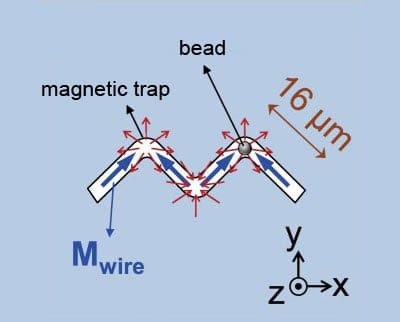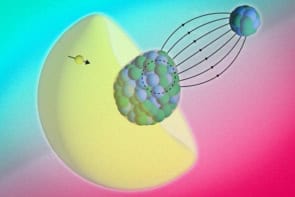
Physicists in the US have created a magnetic trap that can contain microscopic particles despite their Brownian motion. The trap, which is based on a magnetized, zigzag-shaped nanowire, could help researchers to perform chemical or biological experiments in a microfluidic environment, where fluids are geometrically constrained to a submillimetre scale.
Microfluidics is a nascent field that involves shifting picolitre quantities of liquids through micron-width channels. The ability to perform measurements on tiny quantities is useful to many researchers in chemistry, biology and medicine who have to work with materials that are expensive or difficult to synthesize, such as new drugs. Moreover, several microfluidic systems can be incorporated together, allowing the creation of “lab on a chip” platforms for the study of many chemical processes at once.
A key requirement of microfluidics and nanotechnology in general, however, is the ability to manipulate the path of objects in the 100 nm to 10 µm range, where random, thermally driven movements – so-called Brownian motion – play a big role. Different techniques have been put forward, but each has drawbacks. For instance, optical tweezers can trap particles with the electric field created by a focused laser beam, yet this process can cause local heating. Meanwhile, dielectric tweezers operate by imposing an electric field between electrodes, yet these too can affect the local environment.
Magnetic zigzagging joysticks
Now, Aaron Chen and colleagues at Ohio State University in Columbus, US, have come up with a particle trap that may present a way around these difficulties. The trap consists of a magnetic wire made of iron and cobalt that the researchers pattern in a zigzag shape on a silicon surface. The researchers first apply a strong magnetic field so that the wire’s magnetization points towards or away from each vertex, generating monopole-like fields that act as magnetic traps at the vertices. They then apply weaker magnetic fields, which tune the strength of the trap and thereby change the behaviour of the particles.
The particles Chen and his group used were iron oxide encapsulated in a polymer, with a total radius of 0.28 or 0.6 µm. This composition lent the particles a superparamagnetic character, so that they could be magnetized in the trap’s relatively weak fields without displaying any remnant magnetization themselves. Using a CCD camera, the researchers saw that the particles stayed in the trap to within 100 nm. In other words, the trap could regulate a particle’s Brownian motion without pinning it down entirely.
Pros and cons
Stephen Russek, a physicist at the National Institute of Standards and Technology in Colorado, US, calls the work a considerable advance. “In addition to being able to localize and trap a particle at a particular site, Chen et al. have shown they can control its Brownian motion, which is an important step in controlling the reaction dynamics of [any] attached biomolecules,” he says. But, he adds, “The physics is classical and the main breakthrough is a technological one as opposed to [an] elucidation of new physical phenomena. The control of Brownian motion is just one of [several] stochastic fluctuations that need to be controlled to allow precise control of biological processes in vitro or in vivo.”
Lars Egil Helseth, an expert in magnetic traps at the University of Bergen in Norway, agrees that there are still drawbacks to the Ohio State researchers’ technique. “Their microstructure is fixed, and cannot be moved around at will to capture beads as one could do with optical traps and movable magnetic domain walls,” he says, which is a problem for the many applications that require movable traps. He also points out that the authors use a micron-sized structure, which prohibits confinement and control in very small volumes. “Although parts of the [experiment] are nice, I believe other solutions are required to meet the demands of biophysics, for example,” he adds.
Still, Chen and colleagues now plan expand their technique by moving beyond control of just individual particles. “Investigating how multiple particles interact within a trap like this will be our next main goal,” he says.
The research was published in Physical Review Letters.



